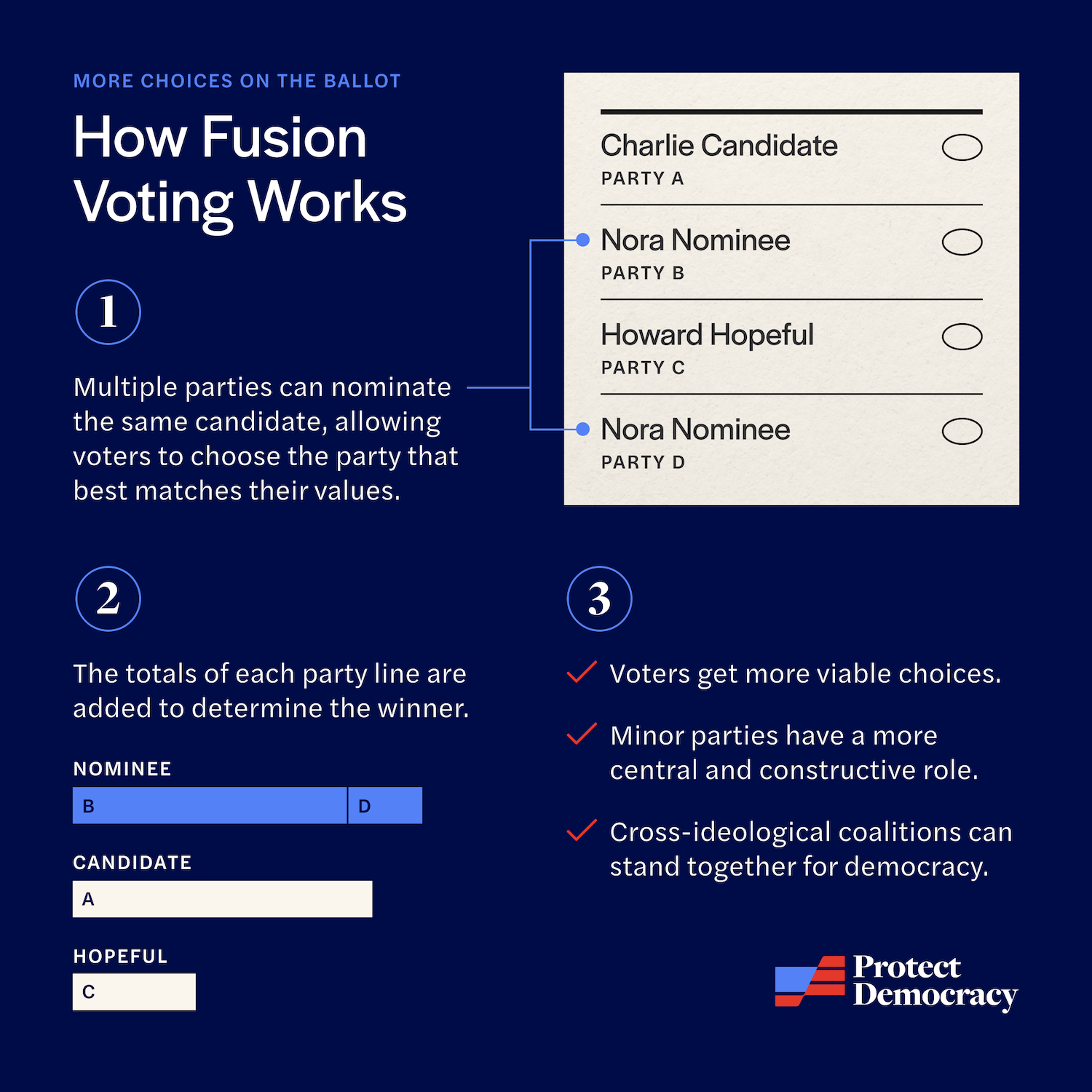United Wisconsin believes political parties have a right to nominate any candidate, even if a candidate is already endorsed by a major party. “Fusion” nominations would give voters more choices and allow new constructive political parties to form — parties that won’t waste votes or spoil elections.
“Fusion voting” was once common everywhere in American elections, including Wisconsin. This historic electoral concept is just as relevant in today’s political landscape and could be implemented at both the federal and state levels of government. Here’s how it works:
Fusion voting permits more than one party to nominate the same candidate, with votes for that candidate first being tallied separately by the party before being “fused” together to get a final total. A candidate who appears on the ballot as the nominee of one of the major parties could also be listed as the candidate of a second (potentially more centrist) political party if that second party also nominates them and the candidate accepts their support. Fusion allows people to vote for the candidate they favor and do so on the party line that best represents their values. And instead of being spoilers, smaller parties can play a more constructive role in our politics–giving voters more choices while not asking them to “waste” their votes on candidates who can’t win.

United Wisconsin doesn’t want to be forced to nominate stand-alone candidates and risk spoiling elections. Instead, we aim to interview and choose between the nominees of the two major parties. A major-party candidate who also garners United Wisconsin’s nomination would then appear twice on the ballot–once under the banner of the major party and a second time under UW’s banner. If the vote for that candidate on the UW line helps them win, you can be sure that the candidate will get the message and pay more attention to the concerns of our voters.
In the 1800s, when fusion was common across America, fusionist parties formed to push for all kinds of concerns. Anti-slavery parties used fusion to force the abolition issue forward in the 1840s and 1850s, while in the latter half of the century populist, workingmen, suffragist, and temperance parties used fusion to give voice to those issues. And it was fusion parties that helped to form the Republican Party right here in Wisconsin in 1854. Today, fusion voting could be used by the multitude of politically homeless centrist voters to pull the major parties more toward the middle of the political spectrum.
The Wisconsin Difference
The 2016, 2020, and 2024 presidential elections in Wisconsin were won by very narrow margins. In each case, the nomination of an organized centrist party empowered by fusion voting could have swung the election in a different direction. Indeed, if fusion had been legal in Wisconsin–the “most purple of purple states”–and a center-party nomination were up for grabs, it would have made a difference in the major party platforms and the issues addressed by state and other federal candidates, both before and after the election.
Questions:
Q1. What kind of base would a centrist party be able to build?
- Current polling shows that more than a third of voters self-identify as independent of the two major parties and, in most cases, as ideologically centrist. Under fusion voting, a centrist party would need to deliver only a fraction of these voters to make the difference in competitive races, as noted in the 2016 and 2020 examples. Fusion voting allows groups of centrist voters to have a meaningful voice in the outcome of elections.
Q2. Could a centrist party help both ideologically moderate Republican and Democratic candidates?
- Absolutely. Ideologically moderate candidates in both parties will gain from the growth of a credible centrist party. That’s because voters who want to see the government move away from extreme ideology and towards broad-based policies that benefit the state and country as a whole will now have a viable choice at the polls.
Q3. What about the extreme left and right? Won’t they form fusion parties that yank the Democrats further to the left and Republicans further to the right? Won’t that make us more polarized, not less?
- Fusion voting in the 21st Century will actually reduce the extreme partisanship that exists currently between the two major political parties by creating an incentive for political cooperation, collaboration, and compromise through coalition building with voters in the center of the political spectrum. It will, in fact, allow centrists to re-assert themselves by identifying and organizing as a political entity. By having a centrist political party with nominated candidates on the ballot, voters can do more than say they are ideologically moderate–they can actually demonstrate that commitment with their votes. Instead of separating us further politically, that should bring us closer together.
Q4. Will this benefit one major party over another?
- It could benefit or hinder both major parties, depending on the race and the candidates. The biggest beneficiary of fusion voting–both in the short and long term–will actually be our democratic system of government because it will give voters more meaningful choices, increase competition, and in today’s hyper-polarized climate it will empower centrist voters to reassert their influence in both political parties, not just one or the other.
Summary
Unless we change the current rules of the road for the American political highway by re-establishing a pathway for voters down its center, our democratic system of government will be difficult to sustain. Fusion voting is not the only structural political reform needed in Wisconsin and around the country but, in the current moment, it’s the achievable one that we need the most. Download a fact sheet here or see our elevator pitch here.
More reading…
The Case for More Parties: A Path Beyond Our Broken Two-Party System, by Lee Drutman, Boston Review, September 2024.